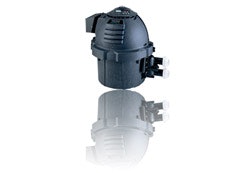
While the savings are compelling, there are a number of practical considerations that should be presented to pool owners as they decide whether to spring for a new heater.
The 85 Percent Solution
The first and most convincing argument for a new heater is direct payback for the investment through lowered utility bills. The new heaters have raised the efficiency bar compared to the older units. How high? Precisely to 85 percent.
The problem is condensation - that familiar phenomenon of tiny water droplets forming on the side of a water glass on a humid summer's day. Any heater more than 85 percent efficient is inevitably going to condensate, says John Watt, technical training product specialist, Pentair Water Pool and Spa, Sanford, N.C.
This condensation is ordinary water and perfectly harmless when it forms, he explains, but it soon combines with the byproducts of combustion and becomes very acidic.
From that point on, the news is all bad. This acid attacks the outside of the heat exchanger causing corrosion, and that corrosion causes restriction, and the exhaust gases can't get out causing a rich mixture, and you're on your way to a Three-Mile-Island heater meltdown.
In light of this 85 percent barrier, Watt says, "We've designed our heater to perform right at the edge [of the 85 percent limit] so that it's a non-condensating heater, and we won't have to deal with those issues as long as it's installed properly and proper flow is maintained."
Manufacturers are capable of producing heaters with over 90 percent efficiency, but these are more complex and expensive in order to deal with the acidic condensation.
"The higher-efficiency heaters," says Bruce Aubrey, product manager for heaters and heat pumps, Hayward Pool Products, Elizabethtown, N.J., "have two heat exchangers, and one has to be stainless-steel construction because of the acidic exhaust gases. And these are just so much more expensive, the payback just isn't there."
Better Management
The new heaters don't just save energy within the heater itself; improvements in flow management through the heater make it less restrictive to water being circulated by the pump, and therefore save on that component's large electric bill, as well.
"We are talking about a 20 to 30 percent savings on a customer's electric bill," says Aubrey, "through the hydraulic efficiency of the heater. It's more efficient because only about 20 to 25 percent of the circulating water goes through the heater. The rest is bypassed, which is a more efficient way of getting the water that's not going through the heat exchanger back to the pool.
"When you look at a gas heater, most of them have some kind of bypass mechanism inside a large plastic header. Some are efficient and some are very inefficient. We have one header, for example, that is so efficient that you can drop down one pump size on your equipment pad. So instead of using a 1.5-horsepower pump, you can use a 1-horsepower pump with that heater because you don't have that pressure drop across the heater.
"So you get a savings on your pump cost [by buying a lower horsepower pump] and pump energy cost in addition to savings from a more efficient heater."
Get The Turbo
"With a new heater you are not only going to see improvements in efficiency and reliability," says Watt, "but you'll help the environment, as well. And not just in terms of fuel efficiency, but by lowering NOx emissions."
A key advancement in improving all these things - efficiency, reliability and NOx emissions - has been the incorporation of an inlet air assist fan. It's a device that is something like a supercharger on a car engine.
Much like cars advanced from naturally aspirated engines to turbocharged engines when they added a compressor fan to cram more air into the combustion chamber, pool heaters have added a fan which forces air into the combustion chamber for a more controlled, efficient burn.
"The fan gives you a very precise air/fuel mixture for combustion," says Aubrey, "and by giving you a more precise mixture, you get more efficient combustion, and therefore heating. And that's what reduces your pollutants and NOx."
The other nice thing about fan-assisted combustion or "power venting," is that it eliminates downdraft issues. Downdraft occurs when you get a strong gust of wind over the top of the heater or down over a wall behind a heater, which overpowers the heat's natural movement up and out of the heater. It forces the heat and flame down toward the burner tray and out the front of the heater, causing it to "roll out," which is a serious problem for pool heaters.
The fan-assisted combustion chamber is essentially impervious to atmospheric conditions - wind and rain do not affect it.
Currently, such fan-assisted, low-NOx heaters are the only kind you can buy in California, Texas and Pennsylvania - these states mandated them half a decade ago. Both Aubrey and Watt have been surprised that other states did not immediately follow suit, but believe the general drift of regulation in that direction has not changed overall.
"I think part of it [the slow national uptake of low-NOx regulation] is that the states of California and Texas have so many pools," Aubrey says. "In other states the proportion of pool heaters to cars and other sources is lower, so there's less concern about the emissions of pool heaters.
"Now with the greater environmental focus of the last year or two, you may see more of it. More people are talking about smog and so forth, and you can reduce that with low-NOx emission heaters.
"The technology is there to do it. But there's so much focus on reducing electricity usage with the multi-speed pumps that the heater is still receiving less attention than the circulation pumps."
Cascading Failure
Beyond efficiency, reliability and ecological compatibility, new heaters offer pool owners an even more cherished imperative - convenience. Or rather, they eliminate the annoying inconvenience of a dying heater and its cascade of failures.
Older heaters are prone to requiring service calls in series, where root problems manifest symptoms that are addressed one-at-a-time, at $100 or so a pop.
Such root problems can be difficult for a tech to spot, and without addressing the cause, Watt says, you go into a long drawn out process of spending more money than you need to.
"The No. 1 example of that situation is a sooted heater," he says, "which is a result of a combustion process that is out of the appropriate range."
Once a heat exchanger begins to soot, it will continue to soot even after repeated visits from a technician to clean and open the exhaust gas passageways. "If you are getting sooting on an older heater," he says, "it's probably time to replace it. On a newer heater - anything less than 5 years old - I would recommend that you perform the necessary action to make the repair. But you must be very thorough. Don't look at the failure, look at what caused the failure."
Out Of Stock
In replacing failed parts on older heaters, a secondary challenge often presents itself, says Tony Napolitano, owner, Professor H2O, Los Angeles, a pool service entrepreneur with years of field-related experience at Pentair.
"It's almost impossible to find parts to make repairs on some of the older models. The basic stuff, the water pressure sensor, the pilot assembly, the thermostats, the gas valves, that stuff is all fairly readily available, but you get into the bigger components, the water jacket assemblies and so forth, that's getting almost impossible to find."
Unfortunately for the pool owner, once the problem has been identified and the obsolescence of the part has been discovered, the unit has usually been out of operation for some time.
Napolitano has a service-oriented perspective on the technological advancement of pool heaters. "Although they have advanced technologically with the onslaught of low-NOx, draft induction and digital LED boards, a heater is still essentially what it's always been - water goes in and out, gets heated by burners through a heat exchanger.
"The difference is that now they have both a heart and a brain," he says, "the heart of the heater being the gas portion - the gas valve, the burner assembly. The brains are the electronic component, the digital display boards, and ignition module.
"Some guys are afraid of the new technology, but they've really got to just break it down into its simplest form and realize that other than a few components that have been added for convenience, the heart of the heater has not changed.
"It's just like a car. Car engines have gotten fancier and higher tech, there are computers onboard, diagnostics, this and that, but if you really break it down, it's still just an internal combustion engine."












































